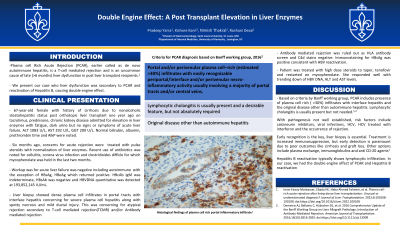Sunday Poster Session
Category: Liver
P1030 - Double Engine Effect : A Post Transplant Elevation in Liver Enzymes
Sunday, October 22, 2023
3:30 PM - 7:00 PM PT
Location: Exhibit Hall

Has Audio
- PY
Pradeep Yarra, MD, MSc
Saint Louis University Hospital
St. Louis, MO
Presenting Author(s)
Pradeep Yarra, MD, MSc1, Kishore Karri, MD2, Nimish Thakral, MD2, Roshani Desai, MD1
1Saint Louis University Hospital, St. Louis, MO; 2University of Kentucky, Lexington, KY
Introduction: Plasma cell–rich acute rejection (PCAR) is a form of late graft dysfunction ( >6 months) that occurs in 3% to 5% of liver transplant recipients (LTRs) without a prior history of autoimmune liver disease. We present this unique case of PACR and reactivation Hepatitis B virus (HB) hepatitis.
Case Description/Methods: 67-year-old female with history of cirrhosis due to nonalcoholic steatohepatitis status post orthotopic liver transplant one year ago on tacrolimus, prednisone, chronic kidney disease admitted for elevation in liver enzymes (LE). She endorsed dark urine but no signs of acute liver failure. Labs revealed normal bilirubin, albumin, prothrombin time, alkaline phosphatase but elevated alanine transaminase (ALT) at 1083 U/L and aspartate transaminase (AST) 292 U/L with GGT at 200 U/L. Review of records showed concerns for acute rejection six months ago due to elevated LE, was treated with pulse steroids with normalization of LE. She recently took multiple antibiotics due to a history of cellulitis, clostridioides difficile and recent corona virus infections, for which mycophenolate was held. Work up for acute liver injury was done including liver biopsy, acute viral hepatitis panel, infectious, tylenol, and autoimmune serologies. Workup was negative with the exception of HBsAg, HBeAg which returned positive. HBcAb IgM was indeterminate, HBsAb was negative and HBVDNA quantitative was detected at 193,852,145 IU/mL. Liver biopsy showed dense plasma cell infiltrates in portal tracts with interface hepatitis concerning for severe plasma cell hepatitis along with spotty necrosis and mild ductal injury. This was concerning for atypical rejection secondary to T-cell mediated rejection (TCMR) and/or Antibody mediated rejection, which was ruled out as HLA antibody screen and C4d stains negative. Immunostaining for HBsAg was positive consistent with HBV reactivation. She was treated with high dose steroids to taper, tenofovir and restarted on mycophenolate. She responded well with trending down of HBV DNA, ALT and AST levels.
Discussion: Based on criteria by Banff working group, PCAR includes presence of plasma cell rich ( >30%) infiltrates with interface hepatitis and the original disease other than autoimmune hepatitis. Lymphocytic cholangitis is usually present but not needed. With pathogenesis not well established, treatment is increased immunosuppression, but early detection is paramount due to poor outcomes like cirrhosis and graft loss. HB reactivation typically shows lymphocytic infiltration.
Disclosures:
Pradeep Yarra, MD, MSc1, Kishore Karri, MD2, Nimish Thakral, MD2, Roshani Desai, MD1. P1030 - Double Engine Effect : A Post Transplant Elevation in Liver Enzymes, ACG 2023 Annual Scientific Meeting Abstracts. Vancouver, BC, Canada: American College of Gastroenterology.
1Saint Louis University Hospital, St. Louis, MO; 2University of Kentucky, Lexington, KY
Introduction: Plasma cell–rich acute rejection (PCAR) is a form of late graft dysfunction ( >6 months) that occurs in 3% to 5% of liver transplant recipients (LTRs) without a prior history of autoimmune liver disease. We present this unique case of PACR and reactivation Hepatitis B virus (HB) hepatitis.
Case Description/Methods: 67-year-old female with history of cirrhosis due to nonalcoholic steatohepatitis status post orthotopic liver transplant one year ago on tacrolimus, prednisone, chronic kidney disease admitted for elevation in liver enzymes (LE). She endorsed dark urine but no signs of acute liver failure. Labs revealed normal bilirubin, albumin, prothrombin time, alkaline phosphatase but elevated alanine transaminase (ALT) at 1083 U/L and aspartate transaminase (AST) 292 U/L with GGT at 200 U/L. Review of records showed concerns for acute rejection six months ago due to elevated LE, was treated with pulse steroids with normalization of LE. She recently took multiple antibiotics due to a history of cellulitis, clostridioides difficile and recent corona virus infections, for which mycophenolate was held. Work up for acute liver injury was done including liver biopsy, acute viral hepatitis panel, infectious, tylenol, and autoimmune serologies. Workup was negative with the exception of HBsAg, HBeAg which returned positive. HBcAb IgM was indeterminate, HBsAb was negative and HBVDNA quantitative was detected at 193,852,145 IU/mL. Liver biopsy showed dense plasma cell infiltrates in portal tracts with interface hepatitis concerning for severe plasma cell hepatitis along with spotty necrosis and mild ductal injury. This was concerning for atypical rejection secondary to T-cell mediated rejection (TCMR) and/or Antibody mediated rejection, which was ruled out as HLA antibody screen and C4d stains negative. Immunostaining for HBsAg was positive consistent with HBV reactivation. She was treated with high dose steroids to taper, tenofovir and restarted on mycophenolate. She responded well with trending down of HBV DNA, ALT and AST levels.
Discussion: Based on criteria by Banff working group, PCAR includes presence of plasma cell rich ( >30%) infiltrates with interface hepatitis and the original disease other than autoimmune hepatitis. Lymphocytic cholangitis is usually present but not needed. With pathogenesis not well established, treatment is increased immunosuppression, but early detection is paramount due to poor outcomes like cirrhosis and graft loss. HB reactivation typically shows lymphocytic infiltration.
Disclosures:
Pradeep Yarra indicated no relevant financial relationships.
Kishore Karri indicated no relevant financial relationships.
Nimish Thakral indicated no relevant financial relationships.
Roshani Desai indicated no relevant financial relationships.
Pradeep Yarra, MD, MSc1, Kishore Karri, MD2, Nimish Thakral, MD2, Roshani Desai, MD1. P1030 - Double Engine Effect : A Post Transplant Elevation in Liver Enzymes, ACG 2023 Annual Scientific Meeting Abstracts. Vancouver, BC, Canada: American College of Gastroenterology.
